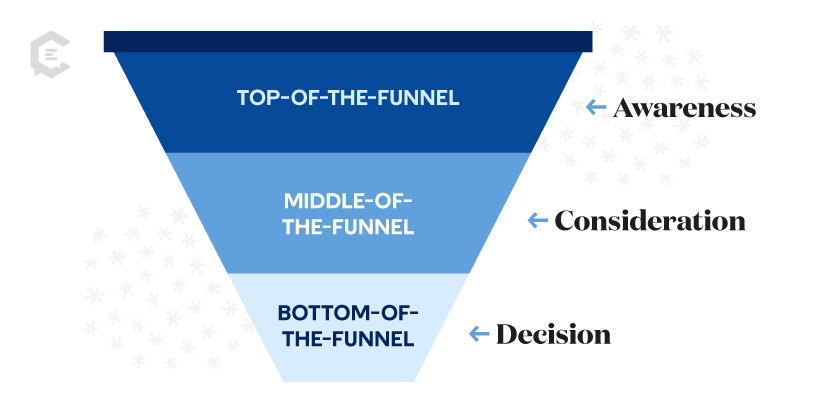In the breakneck race of the online world, if you don’t grab attention from the get-go, you might as well be invisible. And if you’re a marketer aiming to be the Usain Bolt of the digital track, your starting line is right at the top of the sales funnel.
Top-of-Funnel (TOFU) content isn’t just another fancy acronym in the marketing soup. Oh no! It’s your first hello, your foot in the door, your charismatic wink from across the room. We’re talking about content that’s laid-back, chock-full of knowledge, and — here’s the kicker — totally non-pushy.
Looking to dominate those generic, big-fish industry queries? Or maybe you want to slide into your audience’s DMs with the confidence of a trusted brand? Well, TOFU’s got your back.
This comprehensive guide covers best practices for top-of-funnel content creation, steps to build an effective TOFU content strategy, and actionable insights to measure success.
Understanding Top-of-Funnel Content
The Awareness Stage
Top-of-funnel content meets the consumer at the first stage of their journey. It’s the initial step and often the most critical in demand generation.
Here’s a breakdown of the content marketing funnel for the buyer’s journey:
- Top-of-the-Funnel: Awareness
- Middle-of-the-Funnel: Consideration
- Bottom-of-the-Funnel: Decision
At the top-of-the-funnel, consumers are aware of a problem or something they need to fix. But they often don’t necessarily know the solution they need. They might not even be aware of the potential solutions out there. That’s where TOFU content shines. It doesn’t push a product or service aggressively. Instead, it offers insight and education into the problem the consumer is having. That education provides utility and value to the reader and nudges them toward a possible solution. You.
Why TOFU Content is Crucial to Your Content Marketing
95% of marketers create Top-of-Funnel content. That should tell you how essential it is.
And while leads and conversions are the ultimate goals of any marketing strategy, the journey there is just as vital. Ultimately, any piece of TOFU content should somehow connect to your product or service. Think of top-of-funnel content as casting a wide net into the sea of potential customers. That net is designed to provide relevance, education, and value. It hooks and attracts consumers, starting them down the consumer decision journey.
By leveraging the power of TOFU content, you can engage your target audience and set the tone for the rest of the buyer’s journey.
Building an Effective Top-of-Funnel Content Strategy
Crafting a resonant TOFU content strategy requires deep diving into demand metrics and competition. Let’s unpack the essential components that drive a successful top-of-the-funnel content game plan.
Getting an Understanding of Your Keyword & Content Consumption Universe
If you want your brand to stand out in the digital landscape, you have to understand the myriad of pathways that guide your audience to you. And that means getting clarity. From an SEO standpoint, it’s not just about spotting high-volume keywords. It’s about organizing those keywords into themes and going deeper by identifying every possible keyword variation that might stem from them.
Organizing your data by theme, importance, and volume creates a blueprint for your target audience’s journey. It unveils what your audience is searching for and provides insights into their pain points and curiosities. With that understanding, you can tie this data to your UVP and OKRs and begin to develop a top-of-funnel strategy for success.
But before you do, you also need to understand your competitive landscape.
Looking at the Competitive Landscape
Success in content marketing often means knowing and adapting to the competition.
Analyze what Google’s rewarding with good rankings and see what everyone ranking on page one is doing with their content. Then, ensure you’re doing everything with your content to match that. Are all the top-ranking pages using 1,200-word articles? You need to have 1,200 words. Do they incorporate lists, data visualizations, or interactive FAQs? You have to do that too. Adopt and adapt. And it’s not about imitation. It’s about taking cues from what’s rewarded and then infusing it with your brand’s unique tone of voice.
The Skyscraper Approach
Architects of skyscrapers never settle for the middle. They want their building to be bigger than any other skyscraper out there. In the realm of top-of-funnel content creation, that mindset means matching your competition, then exceeding them.
First, identify the digital “skyscrapers” for your TOFU keyword or niche. What site is Google ranking number one for your target keyword? That’s the pinnacle. Then, look at their characteristics and build them into your site or page. But here’s the key – brainstorming what you can add to top it. Think of elements you can incorporate to make your content even more valuable than theirs.
If you want to go the extra mile, once you’ve built your own “skyscraper” that’s exceeded the competition, reach out to sites that link to the skyscraper you just surpassed. Introduce them to your superior resource and pitch it as an enhanced tool that offers more value to their users. It can be a massive boost for your site if they choose to stop linking to the competition and link to you instead. That sets you up for success to overtake them in the rankings.
Starting Broad and then Organizing Your Universe Accordingly
Knowing your entire universe and organizing it into a hierarchy is also essential. First, lock down your macro themes that encompass everything. Once you have those, you can break them into sub-themes catering to your target audience segments. And it doesn’t stop there. Each sub-theme can break down into even more specific niches.
Let’s take a broad theme like “Digital Marketing.” Within that, there are natural sub-themes like “SEO,” “Paid Advertising,” and “Content Marketing.” If you dive deeper into “SEO,” you’ll find even more specific themes like “On-page SEO,” “Link-building,” and “Technical SEO.” And so on.
This hierarchical approach serves two purposes:
- It provides a clear structure to your content strategy and enables you to pinpoint gaps, overlaps, and expansion opportunities
- It fosters connectivity between all of your content as each piece of content becomes part of your broader narrative
Linking all your content together creates a web of resources that keeps your audience engaged and guides them through their journey. All of which deepen their relationship with your brand.
Making Sure Your Content Systematically Relates to Each Other
To demonstrate how your top-of-funnel content should relate to each other, let’s use the example of Target. Target has a massive range of categories at its store. For our purposes, we’ll focus on “kitchen appliances.” Through research, we might find there’s a high search volume for “Best Countertop Kitchen Appliances.” So you create a TOFU long-form piece about that topic.
But that piece also introduces blenders, air fryers, and coffee machines as some of the appliances. Each of these serves as an entry point into a deeper sub-topic. That means they should have links to pieces of content about their specific sub-topic. And those sub-topics of each appliance can link to another top-of-funnel piece of content that’s even more specific.
Example:
“Best Countertop Kitchen Appliances “-> “What are Air Fryers” -> “Top Ten Air Fryers” -> “Top Air Fryer Recipes.”
All these niche topics must loop back, linking to your primary article about “Best Countertop Kitchen Appliances.” So, you have all this internal linking that’s enhancing user navigation as you guide them where to go and find more things they’re interested in. It also signals to Google that you’ve built this repository of great content that all interrelates. And that builds trust and authority in Google, which then ranks you higher because of the quality of your database.
So you’ve created this hierarchy of the primary, most competitive, and highest searched topic, “countertop kitchen appliances,” which garners massive search volume. And the sup-topics like “air fryers” hold their own with a lower but still significant number and so on down the line. Now, you’re converting topics at multiple levels of searches and catering to various audience segments. If the user found your top-of-funnel content useful and engaging, they’re more likely to return and purchase from you.
The Hub and Spoke Strategy
Think of a bicycle wheel. Picture “Best Countertop Kitchen Appliances” as the hub. Extending from it are the spokes that stem off from the hub. These would be your sub-topics like “coffee makers,” “air fryers,” and “blenders.”And you can always keep adding and creating new wheels. Each spoke in itself could become a hub with its own spokes, leading to a dynamic, ever-growing connected ecosystem of content.
The initial hub topics for your site should be central to your more competitive keywords. Their competitiveness speaks to their ability to draw substantial search traffic. And despite being a challenge, a comprehensive long-form content strategy will increase your chances of ranking and make the effort worthwhile.
A Rising Tide Lifts All Boats
Internal linking plays a pivotal role in SEO. The “authority” that your hub garners propagate through its spokes. When Google assigns a page authority to URLs, that authority distributes to pages it links to. Moreover, the hub gets its authority from internal and external site links.
The more authority your primary hub amasses, the more it can bestow on its connected spokes. So, as you build authority into your pivotal pages, that authority starts to “lift” all the pages around it. That fosters an environment where all of your content rises in rank and relevance together. This strategy is especially effective if you have that page authority within a well-architected, navigable structure linking Google to a long thread of relevant pages.
Pick your Battles Strategically
Let’s say you’re a small, budding business. You’ve identified a top-of-funnel content topic that gets searched 150,000 times a month. It can be really tempting to focus on and go after that topic because it represents a ton of traffic you could acquire. But your website doesn’t have the authority to rank for those keywords because you’re competing with established “monster” websites.
Example: You’re a small personal finance website growing its authority and following. But when it comes to the most popular search topics in that industry, you’re going up against sites like NerdWallet and Credit Karma.
Instead of facing them head-on, take a nuanced approach. Find peripheral, long-tail topics and keywords that relate more specifically to your service and have less volume. Less volume usually means less competition. And that means a better chance at quickly ranking higher on page one SERPs.
Choosing your battles serves two primary purposes. First, you’ll see a more immediate return on your content investment. And second, you’ll start steadily building authority for your website with a bottom-up approach. Over time, as your site gains traction, you can then go after those more competitive topics. In essence, start with the spokes and build up to the hubs.
Common Mistakes to Avoid in Top-of-Funnel Content Strategy
Writing too much TOFU content about the same thing
It can be tempting to approach a popular topic from multiple angles. But doing so might inadvertently lead to overlapping content. You need to be isolated in your topics and themes. If you write one post that’s about “best countertop kitchen appliances,” you don’t want to write another piece that’s “best countertop kitchen appliance reviews.” And you definitely don’t want to write multiple pieces that address the same topic.
If you do, it dilutes the impact of your core content and sends mixed signals to search engines. Google may get confused and not know which page to rank. This internal competition, often called keyword cannibalization or blurring, reduces the chances of either piece ranking highly. So, be very judicious and exclusive with your topics. Each article or piece you craft should have a distinct purpose and target a specific set of keywords. That approach prevents your content from competing against itself and ensures a clearer path to high search engine rankings and user engagement.
Not Internal Linking
Let’s take our previous example of the countertop kitchen appliance article. In it, it talks about air fryers and coffee makers. But every time it mentions them, it doesn’t link to the applicable articles about each appliance. That’s a missed opportunity. You’ve discussed all these appliances on this authoritative hub page, but Google doesn’t know which page to prioritize for which keyword. Remember when we talked about keyword blurring? There you go.
But, when you internally link to the appropriate sub-topic content when their primary or secondary keywords are mentioned elsewhere, you’re doing two essential things.
Enhancing User Experience: You’re providing readers with a seamless journey that allows them to delve deeper into topics they’re interested in. That gives them an enriching experience on your website that forges a connection with them.
Directs Search Engines: You’re sending clear signals to Google about how you want your pages to rank. By linking the term “air fryers” directly to your in-depth article on air fryers, you’re telling Google, “Hey, this is where readers can get comprehensive information on air fryers. Rank this first.”
In essence, internal linking keeps both users and search engines informed, engaged, and directed. But don’t overdo it. Linking the first mention and maybe one more (if applicable) is plenty to tell search engines what content is most relevant.
Not Paying Attention to the Competitive Landscape
In the digital race for relevance and visibility, understanding your competitors is as crucial as knowing your content. You must constantly calibrate your strategy in light of who and what you’re up against to unlock your competitive advantage. Do your due diligence to see who’s ranking in the top 3-4 positions on page one of Google for the keywords you want to rank for. Then, investigate the characteristics of those pages. Analyze their:
- Content length
- Internal linking
- External backlinks
- Depth
- Structure
- Multimedia usage
- User Engagement
Then, you need to craft content that’s as good, if not better, than those pages to participate on page one. Think of the skyscraper example from earlier. Identify if there are any gaps in the competition’s content or structure. What’s something unique you can add to fill that gap and boost yourself above them?
Example: A company wants to create a 1,000-word blog on a critical topic for their business. They know people search for it a lot. You’re preparing to write it. Then, you go on Google and see that all the websites on page one have in-depth 3,000-word articles. Writing an article that’s not 3,000 words puts you at an immediate disadvantage.
We often see marketers creating content without looking at Google SERPs and essentially underfunding their content based on market value – they likely never rank on page one.
Measuring the Success of Your TOFU Content Strategy
Number of Ranking Keywords
When creating long-form content for top-of-funnel, you’re not just looking to rank for one keyword. You want to rank for dozens, if not hundreds, of keywords. When you pull data for your URL, a good piece of long-form content should rank for 200-1,000 keywords. Hopefully, it’s a combination of the long-tail keywords (specific queries) you’ve addressed in your article and all the different permutations of those keywords.
Understanding Keyword Traffic
Think about it like this. Let’s say you have 1,000 keywords. Conventional logic might compel you to focus on the major ones. But consider this: if 95% of these keywords get one click a month, that’s 950 clicks. Conversely, the other 5%, your “top” keywords, bring in 50 clicks each. That’s just 250 clicks in total. The verdict? Your long-tail keywords got you almost 4x the number of clicks than your big keywords.
Tracking Keyword Performance
Once you’ve identified the volume and variety of your ranking keywords, the next step is to meticulously track them. How are they evolving? Are they steadily climbing the ranks and funneling more traffic? Have they plateaued? Monitoring all of these metrics allows you to fine-tune your strategy and ensure your top-of-funnel content remains effective.
Are you ready to elevate your TOFU content?
Top-of-the-funnel content demands a unique blend of strategy, creativity, and a profound understanding of your target audience. If that at all sounds challenging to you, we’re here to help.
Our managed content creation team at ClearVoice can be your catalyst. Talk to a content specialist today to elevate your content game and stand out in the digital landscape.









